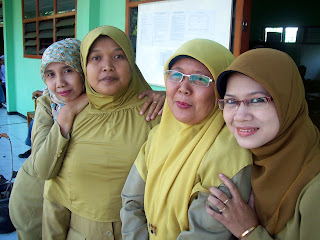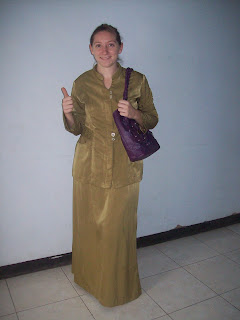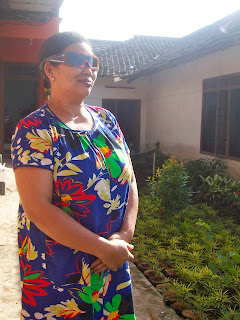I am happy to say that my time in Indonesia has already
taught me a lot about Islam, and I have developed a much deeper understanding
of the faith. For example, yesterday I discussed wearing a hijab with my
friends. Their reasons were thus: if a man sees a woman not wearing a hijab and
short shorts and a tank top, he will desire her. Therefore, women wear hijabs
and long clothing. I asked if it made them upset that they had to do something
that would make them hotter and sweater just because men had a problem
controlling their thoughts, and they said, no, they are used to it. It’s just
normal. And there are various teachings. Some women must be completely covered,
everything but their eyes. It depends on the imam’s teachings. The Muslims in
Mojoagung with me are in the middle, not uncovered but not totally covered.
The more I thought about it, though, I realized that I do
the same thing in the US. I do not wear shorts that are too short and I do not
wear low cut tops a) because let’s face it I’m not stick thin, b) because I do
not feel comfortable, and c) because I do not want unwanted attention. Just
like the women here, I choose to dress in a way that respects my body while
protecting me from unwanted stares. The level to which we cover up is simply
different. Asking me to come to school in short shorts, where I would clearly
be uncomfortable with glances, is like asking a Muslim woman to go to school
and not wear a hijab. She feels too revealing. We have the same intentions,
Muslim women and I, but manifest this with different levels of covering
ourselves up.
Last night I spoke with my host sister-in-law and received a
really big compliment. She said that her parents were really surprised by me.
“How can she eat our food?” “How come she wants to learn about Islam?” “How
does she feel at home here?” They didn’t think an American would want to do all
of these things, yet here I am, always going for the shock factor (Sam, think
cockroach!) This is a really big compliment to me, that they are surprised (yet
presumably pleased!) that I am learning about their faith and culture.
This being said, it was only natural to “go native” as we
say in anthropology, and go pray at the mosque with my family!
|
Allaahu Akbar.
Allaahu akbar.
Allaahu Akbar.
Allaahu akbar
Asyhadu an laa ilaaha
illallaah.
Asyhadu an laa
ilaaha illallaah.
Asyhadu anna
Muhammadar rasuulullaah.
Asyhadu anna
Muhammadar rasuulullaah.
Hayya
‘alash-shalaah.
Hayya
‘alash-shalaah.
Hayya ‘alal-falaah.
Hayya ‘alal-falaah.
Allaahu Akbar.
Allaahu akbar.
Laa ilaaha
illallaah.
|
God is Great! God is
Great!
God is Great! God is
Great!
I testify that there
is none worthy of worship except God.
I testify that there
is none worthy of worship except God.
I testify that
Muhammad is the messenger of God.
I testify that
Muhammad is the messenger of God.
Come to prayer!
Come to prayer!
Come to success!
Come to success!
God is Great! God is
Great!
There is none worthy of worship except God.
|
This is the call to
prayer that I hear 5 times a day, at approximately 4:30 AM, 12:30 PM, 3:30
PM, 5:30 PM, and 7 PM. Oh yeah, I can’t forget to mention that this call to
prayer is blasted over a loudspeaker that, while about a block away from my
window, magically sounds like it is 1 foot from my window. Miraculously,
sometimes I sleep through the call to prayer at 4:30 AM. Sometimes.
The Islamic faith has five pillars, one of which is to sholat, or pray, five times a day. The
other four pillars are: proclamation of faith (“There is no God but Allah and
Mohammad is his prophet”), tithing, fasting during Ramadhan, and visiting Mecca at least once as an adult if
financially able.
Naturally, my interest in understanding the manifestation of
God in other faiths led me to ask my host family if I could follow them to the
mosque on Monday night and sholat
with them. I borrowed a prayer rug, slipped on my host sister’s long skirt
(that I’d pull down over my feet once entering the mosque to pray) and a hijab
that went down to my waist. This skirt and hijab were so long because women’s
feet and hands can’t be showing during prayer. Simply a rule!
I told my host mother, “Ibu, saya tidak bisa lebih siap untuk
ikut ke musholla! Saya selesai menstruasi, sudah mandi, dan pakai jilbab!” Of course she cracked up, because I had
just testified, “Ibu, I could not be more ready to follow you to the musholla (small mosque)! I am done
menstruating (not allowed to enter the mosque if you are), I already showered,
and I am wearing a hijab!”
I’ve only been inside a mosque a few times in my life, and I
have watched Muslims pray approximately three times in my life, including two Eid al’Fitr service sat Carleton, and once
during high school when I visited a Muslim camp with my God camp (Youth in
Theology and Ministry, shout out to St. John’s and St. Ben’s in Collegeville,
MN!) I may have prayed with the women at that point, but I don’t recall…
Anyways, this was the first time I was doing it right!
Excuse me, Lauren and Danielle, this was the first time I was doing it correctly.
After dawning my prayer clothes and slipping off my sandals outside the mosque,
I lined up in the last row of women (women in this mosque prayed on the right
side of a curtain, men on the left, but it can also be women on the left, men
on the right, OR men in front, women in back), I placed my prayer mat facing
Mecca, and was ready for action.
Usually the 7 PM prayer is about 10 minutes long, but it is Ramadhan, so I was attending the regular
prayer time followed by Teraweh. The
next 40 minutes basically consisted of standing, bending at the waist,
prostrating with my forehead touching the ground, and sitting. The Isya’ prayer time (the regular night
prayer) consists of doing this 4 times, so it’s a repeating system. Teraweh
is the same series of motions and prayers, but done in sets of 2, up to 11
times. At each stage of the prayer, people say the Arabic prayer to themselves,
so I just did my own prayers.
So logistics aside, how did I feel being there?
I loved it!
One of the hardest things about leaving the Christian
community at Carleton (though it was easy to leave behind the feelings that I
had to hide my liberal identity and silently disagree with some people’s
conservative theology) was the lack of Christian community after graduating. I
thrive in community and moving to St. Paul lacked the built-in college
community of young people seeking how to be better people. Or at least I didn’t
find the right group in St. Paul. So being here at the mosque among believers
was so comforting. So natural. Everyone praying together, moving in sync.
The only critique I have about the experience is the lack of
time for personal prayer. As Christians, we have a lot of freedom in how we
pray, when we pray, why we pray. During this exercise of ups and downs at the
mosque (putting our Catholic calisthenics to shame, I may add!), there wasn’t
much time for personal prayer. Or if there was, I missed it trying to make sure
I wasn’t standing when everyone was sitting and vice versa! Praying with one
eye open is not my preferred way of prayer, but that’s life for a first-time
mosque-goer!
Anyways, I love being in a country where God is so present. God’
s power is different, here, though. I have gleaned (mainly from a conversation
with my host mom and host sister, so sample size n=2) that Muslims can lead a
somewhat stressful life of trying to please God by following all the rules and
doing good because God will judge you after death. This reaffirms for me my
freedom in being a Christian. I don’t have to do anything but believe in who
Jesus was and what he did. While this is liberating, I also experience some
guilt about this free pass. Does believing in Jesus’ sacrifice make Christians
lazy and complacent? We know that we are always forgiven, so what is stopping
us from doing bad things over and over again? I suppose the idea is that the
more we don’t do bad things, the closer we become to God and the more we want
to please God, therefore resulting in us striving not to be bad. Still, I think
that the humility that Muslims practice is something to be better explored by
Christians. Though the fear of God’s judgment is something I can live without…
From the Classroom:
Frustration begins to arise in the Indonesian classroom. My
10-2 class was interrupted yesterday for an administrator to come in and make
the students clip their nails.
Naughty student? While Ms. Prather in Central High School
would stop the class and wait for the student to be quiet, and occasionally
send a student out of the class to think about their behavior, Indonesian
teachers simply tug their ear. Reminiscent of the USA elementary school
classroom in 1850? I think so!
The ability to write what is on the board and listen to the
teacher at the same time escapes Indonesian students. (Though to be fair, they
never learn to do this in the first place.) I should start a stopwatch of how
much teaching time will be sucked up by standing there in silence waiting for
students to copy what’s on the board… today, 7 minutes to write 10 phrases.
I may take to just walking out of the classroom and not
coming back when students just laugh nervously and take more than 10 seconds to
respond to the simply question, “How are you?” I will try to be patient, but I
don’t care how poorly you were taught English through all of elementary and
middle school, you should be able to respond to this one question as a 10th
grader.
Goal number one with my counterparts? To encourage them to
go to class on time when the bell rings. Usually we are between 5-10 minutes
late, because they are still chatting with other teachers, no big deal.
In other words, there is a lot of work to be done here in
Mojoagung…
In other news:
I think I prevented my principal from being stalked by a
foreigner. He received a Facebook message from an alleged “Peter” from the UK.
My principal isn’t fluent in English, just words here and there. So he used
Google to translate Peter’s English message, which asked for Indonesian
contacts because he is coming to Indonesia on business. My principal wrote a
response, graciously including his name, phone number, and address. Thank the
Lord he showed me the message before he sent it, or Peter could have shown up
at his house! I explained to him that this Peter was probably not legit.
Businessmen from the UK do not ever start a message with “Hello dear” and use
poor punctuation.
Indonesians do not drop everything and watch the Olympics
like we Americans do, and I miss it! I tried to find out when I could tune into
watching gymnastics and swimming here, but it is simply not aired. What is
aired, you ask? Why, soccer and badminton, of course! Indonesian favorites! But
they air live at 1 AM, so I’m not doing that. I guess that the Olympics is not
as bit a deal here when your country only has 22 athletes as compared to the
US’s 530 athletes. I still miss it, though!
I visited a neighboring village the other day to check out
the shoe production…all made by hand, wow! When we asked around if they could make
sandals for me, everyone said, “Size 43? No! We don’t make shoes bigger than
40!” Well shoot! Finally, we found who would, and I picked out the size, color,
style. Then she asked, “How many do you want?” I said, “Just one pair, for me!”
She said, “Oh, you can’t! You must order at least 20!” Turns out, this is a
village that mass produces shoes. No one wants to make one big pair (excuse me,
size 9-9 ½ is not THAT big!!) for the bule!














































